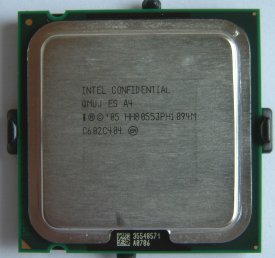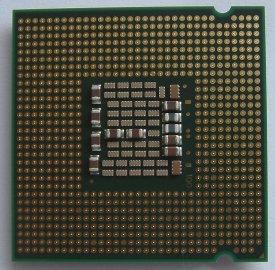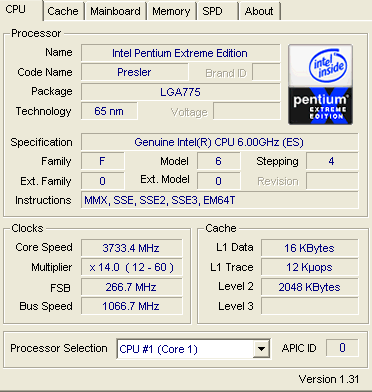Intel Pentium Extreme Edition 965 Processor - what's it all about?
What's so good about Intel's Extreme Edition 965 processor, then? Let's trot out the specification's table and compare it against some healthy competition from both Intel and AMD's high-end CPUs.| CPU | Intel Pentium Extreme Edition 965 | >Intel Pentium Extreme Edition 955 | Intel Pentium Extreme Edition 840 | Intel Pentium 4 3.73GHz Extreme Edition | Intel Pentium 4 670 | AMD Athlon 64 FX-60+ | AMD Athlon 64 FX-57 | AMD Athlon 64 4800+ | Form factor | LGA775 | LGA775 | LGA775 | LGA775 | LGA775 | S939 | S939 | S939 | Manufacturing process | 65nm | 65nm | 90nm | 90nm | 90nm | 90nm | 90nm | 90nm | Cores | 2 | 2 | 2 | 1 | 1 | 2 | 1 | 2 | Clock speed | 3.73GHz | 3.46GHz | 3.2GHz | 3.73GHz | 3.8GHz | 2.6GHz | 2.8GHz | 2.4GHz | FSB | 266MHz (1066MHz QDR) | 266MHz (1066MHz QDR) | 200MHz (800MHz QDR) | 266MHz (1066MHz QDR) | 200MHz | 200MHz (driven clock) | 200MHz (driven clock) | 200MHz (driven clock) | Hyper-Threading | Yes | Yes | Yes | Yes | Yes | No | No | No | Level2 cache | 4MB (2MB per core) | 4MB (2MB per core) | 2MB (1MB per core) | 2MB | 2MB | 2MB (1MB per core) | 1MB | 2MB (1MB per core) | ISA | x86, x86-64, SSE-SSE3 | x86, x86-64, SSE-SSE3 | x86, x86-64, SSE-SSE3 | x86, x86-64, SSE-SSE3 | x86, x86-64, SSE-SSE3 | x86, x86-64, SSE-SSE3 | x86, x86-64, SSE-SSE3 | x86, x86-64, SSE-SSE3 | Thermal Design Point (TDP) | 130W | 130W | 130W | 115W | 115W | 110W | 89W | 110W | Operating voltage | 1.2v-1.3375V | 1.2v-1.3375V | 1.3V | 1.3V | 1.3V | 1.35v-1.4V | 1.4V | 1.35v-1.4V | Transistors | 376m | 376m | 230m | 170m | 169m | 233m | 105.9m | 233m | Virtualisation Tech | Yes | Yes | No | No | No | No | No | No |
So what exactly is an Intel Extreme Edition Pentium 965 processor all about? A little background knowledge on its origins will help.
A bit of Prescott history
Just over two years ago, Intel announced an overhaul for the Pentium 4's architecture. That re-jigged core, codenamed Prescott, superceded the Northwood iteration and was supposed to allow Pentium 4 CPUs to scale to 5GHz and beyond, holding off, by dint of clockspeed above all else, the threat posed by AMD's Athlon 64 CPUs. The LGA775 Prescott was based on a smaller manufacturing process (90nm) and, with respect to scaling, a 31-stage pipeline as compared to the Northwood's 20, which lead to lower performance on a pure clock-for-clock basis against the outgoing core. To alleviate the negative impact of a longer pipeline, Intel issued the Prescott core with 1024kb of L2 cache, a larger L1 cache, and introduced a set of SSE3 instructions that would enhance performance with appropriate applications.As we and many other publications found out, the Prescott core, being a recipient of a die shrink and, consequently, running with at a lower voltage, actually ran 10-12C warmer than an equivalent Northwood-based CPU. Intel's specifications hinted at a TDP in excess of 100W for a 3.2GHz part, making its heat output far higher than expected. The Prescott core, rather than being the Pentium 4's saviour and Athlon 64-beater, looked poor in comparison to AMD's S939 CPUs, with the performance delta the greatest in in gaming tests.
Intel, though, stuck with the Prescott core and turned up the clockspeed every so often. A year later Intel introduced the 600-series of Prescott CPUs, endowed with 2MB of L2 cache, EMT64 (Intel's 64-bit extention to IA-32 architecture), XD Bit, and EIST power-management technology. The fastest single-core Prescott CPU was the Pentium 4 670, running at 'only' 3.8GHz and sporting the extra features afforded by the 600-series enhancements. Overheating problems and poor scaling sounded a premature demise to what Intel originally claimed was a core capable of scaling to 10GHz.
If it's not going to go higher, make it wider, reckoned Intel. That's why, around nine months ago, Intel introduced its first dual-core CPU in the form of the Pentium Extreme Edition 840, amalgamating two identical Prescott cores in one package. The downside to simply adding another core to the underlying architecture was the need for both cores to communicate with the chipset and memory through a single FSB, which was kept at 800MHz. Add in the need to service the CPU's Hyper-Threading, thereby making bandwidth contention into a real issue.
Dual core, though, was here to stay. Fast-forward to today and Intel has kept much of the 'core-glueing' philosophy. The Pentium Extreme Edition 955 CPU, for example, is nothing more than two 65nm Prescott-based (600-series) cores (Cedar Mill) stuck together. Intel bolstered performance by adding in a total of 4MB L2 cache (2MB per core), Virtualization Technology, and a 1066MHz FSB (266MHz QDR). The Extreme nomenclature, Intel said, came from the fact that the CPU's cores ran at 3.46GHz and supported Hyper-Threading, offering a compliant OS up to four cores to work with. Our benchmarks highlighted that it was, before AMD's introduction of the Athlon 64 FX-60 a few days later, generally on a par with the X2 4800+ in a number of multi-threaded applications. The range-topping CPU also gave rise to a number of cheaper 900-series Pentium processors that all packed dual cores, 4MB of L2 cache, 800MHz FSB, and VT tech as standard. Hyper-Threading support, however, remained the domain of the Extreme Edition part.
The Intel Pentium Extreme Edition 965 in particular
That brings us on to the Pentium Extreme Edition 965 CPU. Thinking about what's written above, it's a dual-core processor that features two 65nm Cedar Mill cores. The cores each run at 3.73GHz, up from the 955's 3.46GHz, and feature Virtualization Technology and Hyper-Threading. Both cores share a 1066MHz FSB (8.5GB/s) to the rest of the system and performance is kept topped up by the use of 4MB of non-shareable L2 cache, split equally between the cores. The cost of such a grand design and high cache count is in the use of 376m transistors, which is over 60% higher than AMD's dual-core models, although the benefits of a 65nm process help keep die size below AMD's dual-core range.Intel maintains that the 65nm '965 runs with a maximum TDP of 130W, making it another hottie in a long line of Prescott/Cedar Mill room-warmers. However, that's a maximum TDP under full-load conditions. Intel states that the '965 variant reduces clockspeed and voltage when idle, lowering your PSU's output and saving on your electricity bill at the same time.
The Extreme Edition status signifies at least two aspects. The first is clock speed. The '965 model simply runs with a higher multiplier-factor than the '955, and it's clocked in at 3.73GHz (14x266). Our '955 testing showed it to run reliably at 4GHz+ with reference air-cooling and no rise in voltage, so the extra 266MHz speed gained by the '965 should be a no-brainer as far as yields are concerned. Second, the Extreme status dictates that the '965 is multiplier-unlocked, much like AMD's FX-series, to allow the deep-walleted enthusiast to play with the CPU's FSB to a greater degree. In fact, if you're in possession of an EE '955, simply raise the multiplier from 13x to 14x and you'll have a '965. Easy as pie. Being an LGA775 CPU, the '965 is best-suited to the performance i975X chipset, Intel states, although it would, wouldn't it?
A physical look

Intel seeds the press with engineering samples that feature internal codes. If you see one up on eBay, for example, you know where it's come from. This one's a 3.73GHz '965, guvnor.

Ph00r. Isn't that the loveliest picture you've seen today? Joking aside, the Intel Pentium Extreme Edition 965 processor will effectively remove the '955 from vendors' listings and head the desktop line. Current pricing will see it being introduced at around the £700 mark, replete with heatsink, warranty papers and a nice box. The direct competitor, obviously, will be AMD's Athlon 64 FX-60.

If only it really was a 6GHz model! This may well be the last Pentium 4-based performance CPU coming out of Intel's fabs. That being the case, a 4GHz model would have been nice, or is Intel keeping that back before the release of a certain new desktop CPU that the world currently knows only as Conroe?









